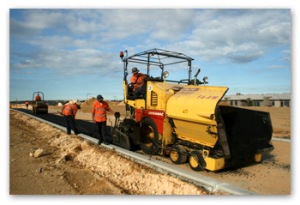Jun 21 2010
In 1970 Perth, Western Australia had a population of just 700,000 and a footprint of approximately 500 km2; less than half the size of today’s metropolitan area and a population of 1.9 million.
It covers a greater area than Mumbai with 80 million people, Cairo with more than 12 million and Shanghai with more than 9 million. Stretching along a north to south coastal corridor developers are filling in the few remaining plots of land to provide housing for the ever increasing population, led by today’s new immigrants.
Predictions are that the population will double to 3.8 million over the next 40 years meaning the City will stretch from Lancelin in the north to a point between Mandurah and Bunbury in the south – covering more than 10 times the surface area it did in 1970.
Western Australia asphalt specialist BGC Asphalt, is fully utilising its Dynapac F6-4W paver laying roads in the last few remaining sub-divisions of Ridge Wood in Brighton, the latest northern suburb of Perth.
 Dynapac F6-4W paver
Dynapac F6-4W paver
BGC’s latest contract, sub-contracted by earthmoving specialist R J Vincent, features laying 6000 m2 of asphalt over three days. A 40 mm base coarse with 14 mm aggregate will be topped by a 25 mm wearing coarse – both sitting on a 200 mm limestone sub-base.
Backing up the Dynapac paver is CP142 pneumatic tyred roller and a CC142 twin drum compaction roller. Across the sub-division, roads are generally 5.5 m wide often with 2.2 m wide parking bays. Outside the sub-division main roads can be 6 m or 7.4 m.
According to gang supervisor, Mick Sheahan, the Dynapac paver is simply “beaut”. He elaborated, “By fitting the extensions, the paver can offer a 3.8 m width making it highly versatile for any road work in the suburbs.”
“- It’s my favourite machine, I just love operating it,” he enthused, “- All the attachments work very well.”
Powered by a Deutz diesel engine, rated at 52 kW at 2300 rpm, the paver “offers tremendous power for a machine this size and it can easily push 47 t gross,” he added.
The paver is rear driven and incorporates a 4-wheel drive and integrated anti-spin system. It provides a maximum placement thickness of 270 mm and offers a capacity of up to 250 t/h.
On the sub-division contract the paver is followed by two vibratory passes by the CC142 and multi-passes with the CP142 until the surface is “firm”. The CC142 then makes two final vibratory passes to remove the possibility of any tyre marks made by the CP unit.
According to Mick Sheahan, depending on the paving speed, pass lengths of around 20 m are made, although, “- this can be increased to 80 m subject to the ambient temperature and weather conditions.”
“- The slide plates are the best ever, just perfect for laying up to the flush kerbs and so easy to set.”
“- Although only delivered last year, the paver has clocked more than 410 hours, testament to how highly we rate it. The paver is just a fantastic machine,” concluded Mick.
Source: http://www.dynapac.com/